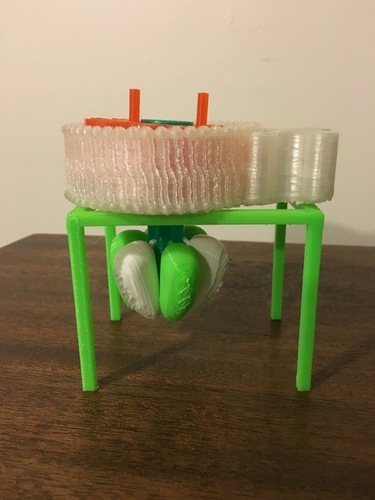
ATP Synthase
pinshape
This model of ATP Synthase (ATPase) lets students explore how a proton concentration gradient stores energy in the form of ATP. Protons are placed into the protein through the hole at the top of the membrane. Each added proton rotates the c-subunit, causing it to drop out the bottom of the membrane. As the c-subunit spins, the alpha and beta subunits move, simulating conformational changes that allow the protein to combine ADP and Pi to form ATP. An actin filament is also included in the model. A fluorescently labeled actin filament was used in the experiment demonstrating the spinning motion of ATP synthase. It would be cool to use a glow-in-the-dark filament to recreate the experiment using a UV light. Print Settings Printer: Da Vinci Jr. Rafts: No Supports: No Resolution: Does not matter Infill: 5% Notes: The only pieces requiring rafts and supports are the actin filament and hydrogen ions. All other files can be printed without rafts or supports. Post-Printing Step 1: Insert the outer column into the bottom of the membrane, lining up the tabs. Step 2: Insert alpha/beta subunits into the slots in the outer column at a 90-degree angle. Step 3: Once the subunit slides in, rotate it to a vertical position. Step 4: Insert the axel into the c-subunit, making sure the bump on the axel lines up with the outline in the top of the subunit. Step 5: Insert the axel into the outer column, ensuring the bump on the axel aligns with the outline on the column. Step 6: Place the model on a frame. Optional: attach the actin filament by inserting the columns on the c-subunit into the holes on the filament. Standards NGSS CCSS Overview and Background Understanding protein function is crucial in biology courses. Students need to grasp how structure relates to biological molecule function. This ATP synthase model lets students see how its structure enables it to produce ATP molecules in the electron transport chain. The model should be used after teaching about protein structures, with students familiar with cellular respiration, specifically the electron transport chain in mitochondria, ions, concentration, and diffusion. Lesson Plan and Activity Before using the model, ensure students understand how energy is stored in a concentration gradient and how a hydrogen ion concentration builds up in mitochondria. Explain that the small balls represent protons and ask what will happen if most of them are on the upper side of the membrane. Students can use the model to explore where these ions go and how the c-subunit spins to move them through the membrane. They should notice how the spinning causes the lower section of the protein to move, using this energy to combine ADP and Pi to form ATP. The discovery of ATPase's movement can be re-enacted by using a fluorescent actin filament. Students can design an experiment or follow the one done in the original experiment. The fluorescent filament was attached to the protein, its position measured over time with a camera (use glow-in-the-dark filament for the actin filament and a UV light if possible). Materials Needed No other materials are needed besides the model. Objectives Students will describe how energy from a concentration gradient is transferred into ATP molecules. They will label and describe different subunits of the ATP synthase protein, describing the process by which the body creates ATP. Students will describe the experiment and data used to show that ATP works like a spinning protein and hydroelectric generator. They will explain fluorescence. Results Students should be able to describe how energy in a concentration gradient is converted into chemical energy for ATP. The model serves as a launch point for further discussion on subunits, structure, and other proteins. Students can research the mechanisms by which ATP is formed chemically and the effects of toxins, drugs, and diseases on these proteins.
With this file you will be able to print ATP Synthase with your 3D printer. Click on the button and save the file on your computer to work, edit or customize your design. You can also find more 3D designs for printers on ATP Synthase.
